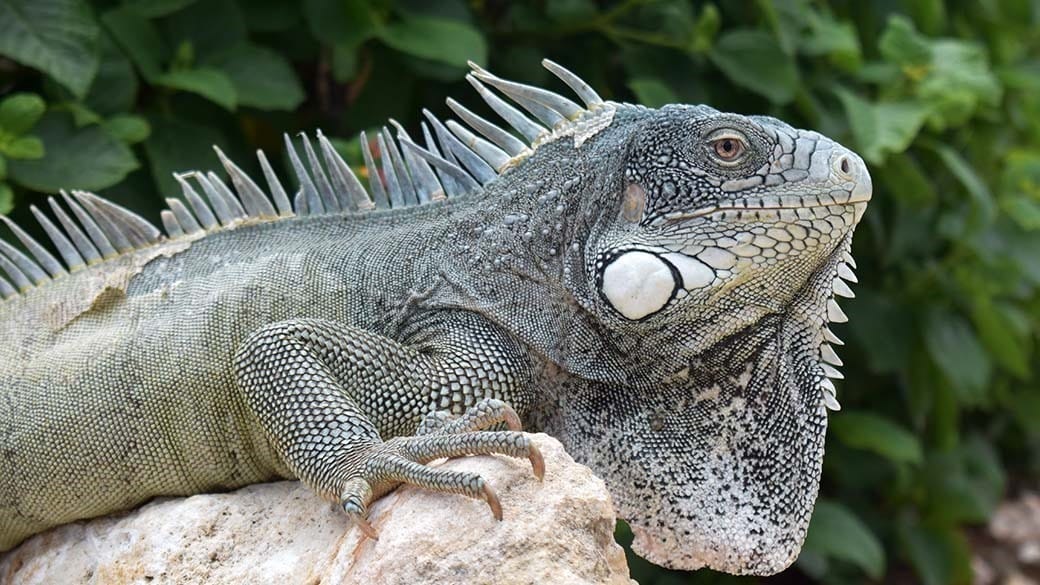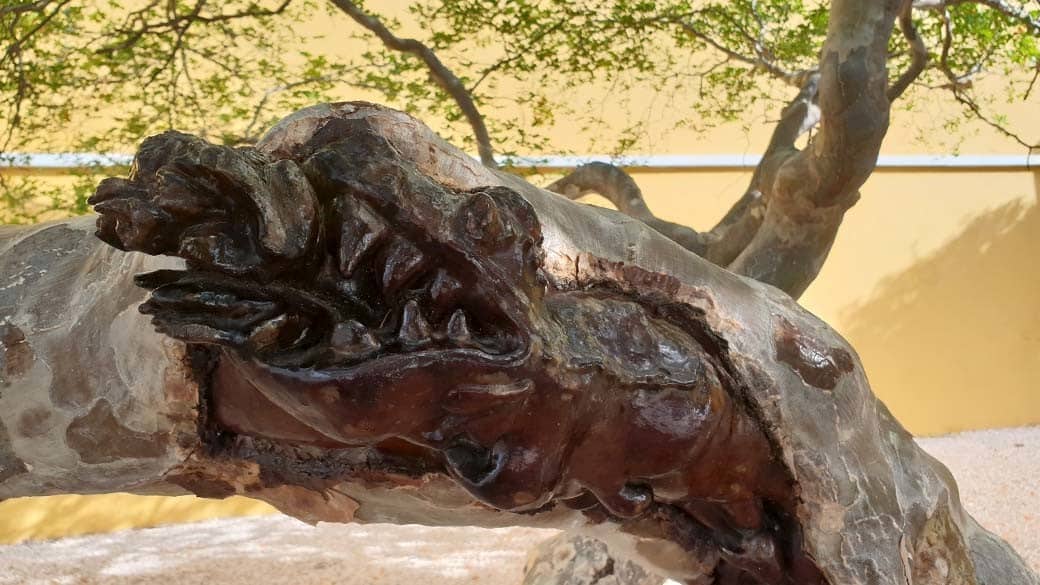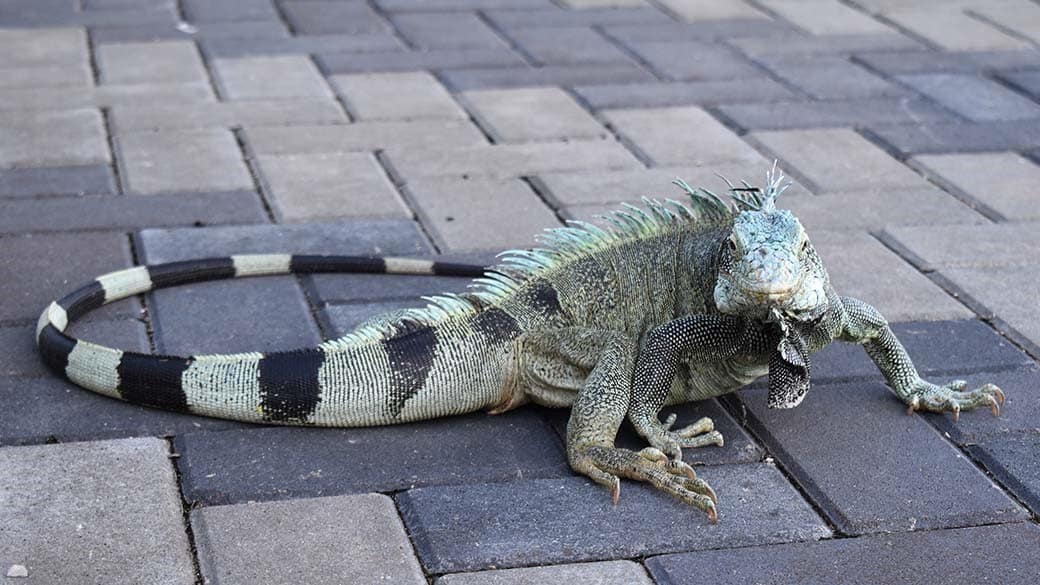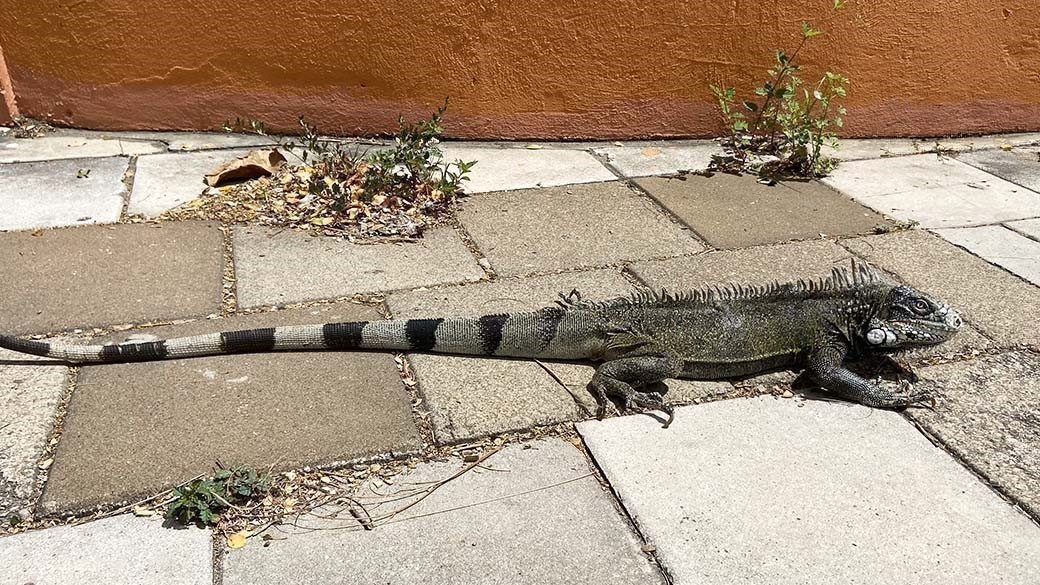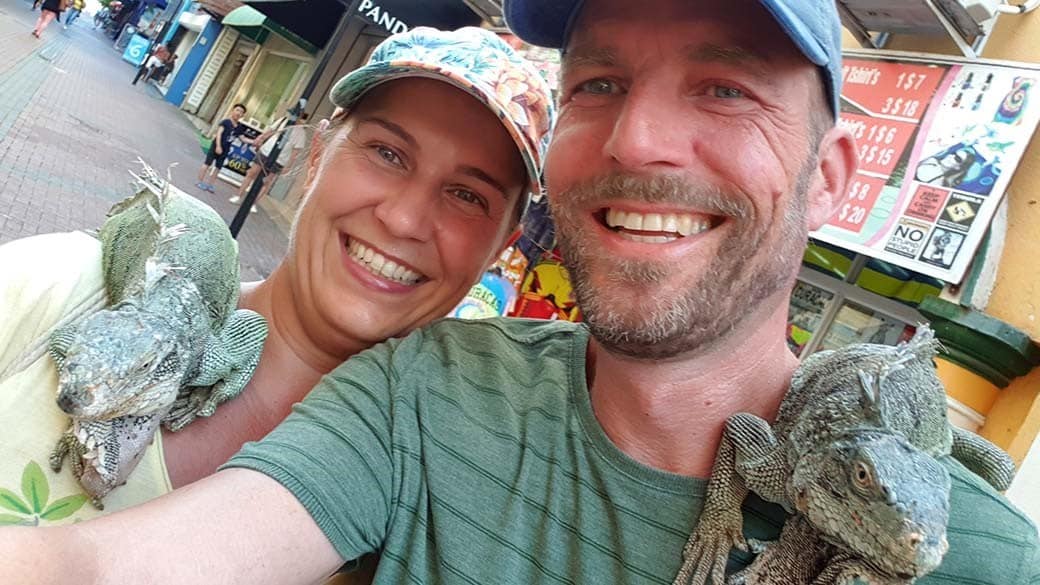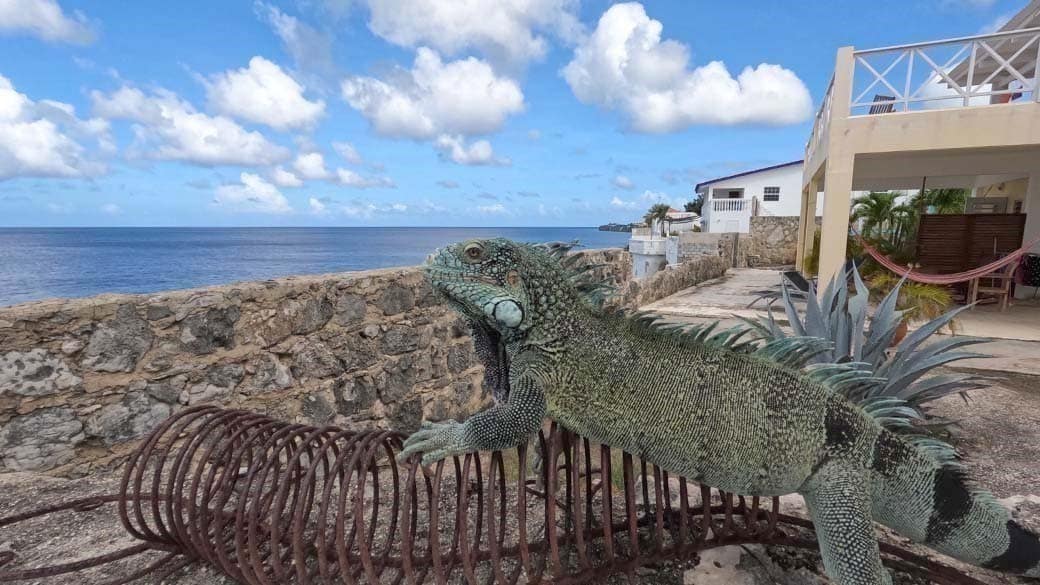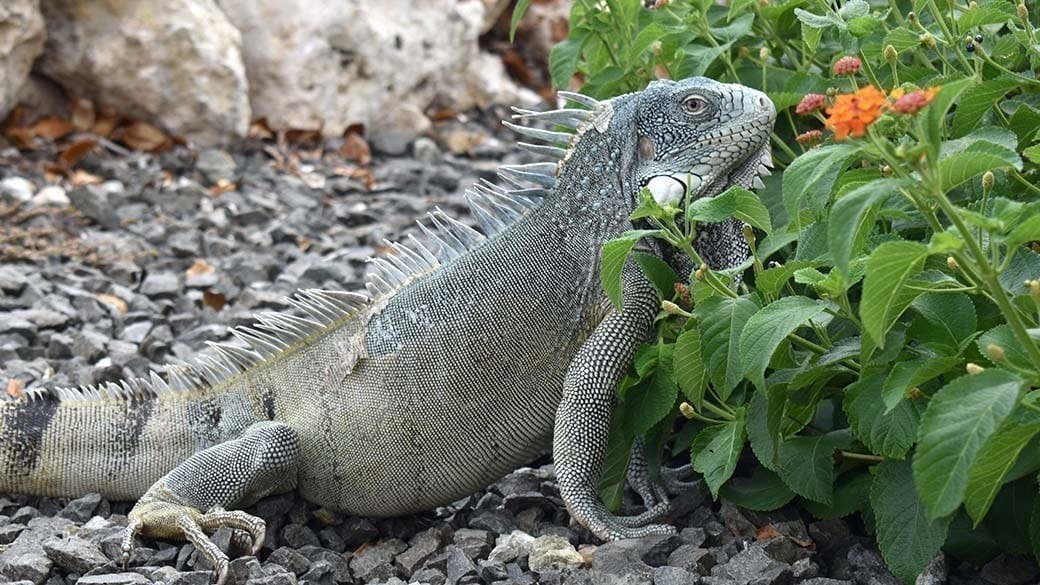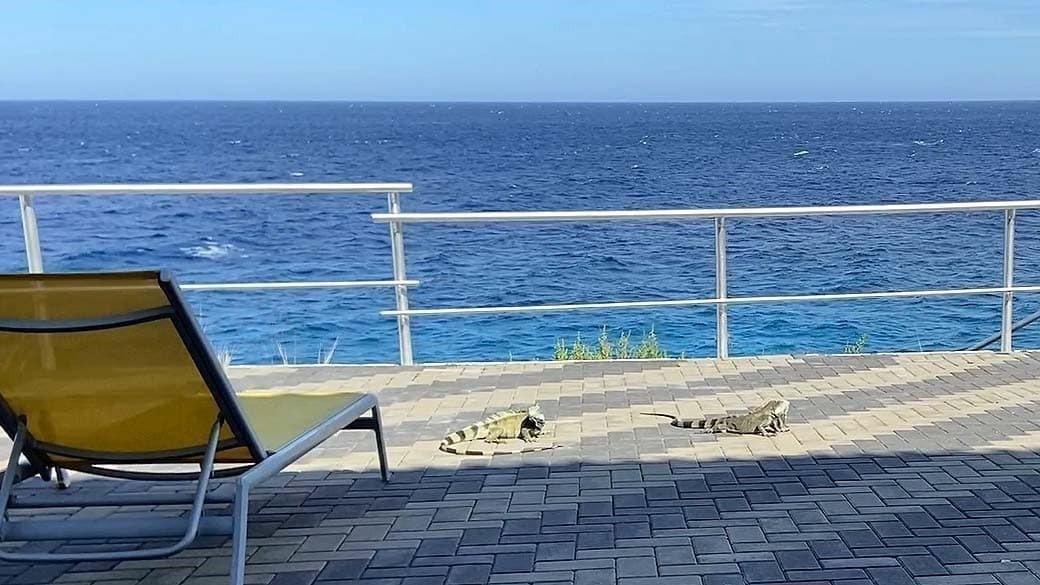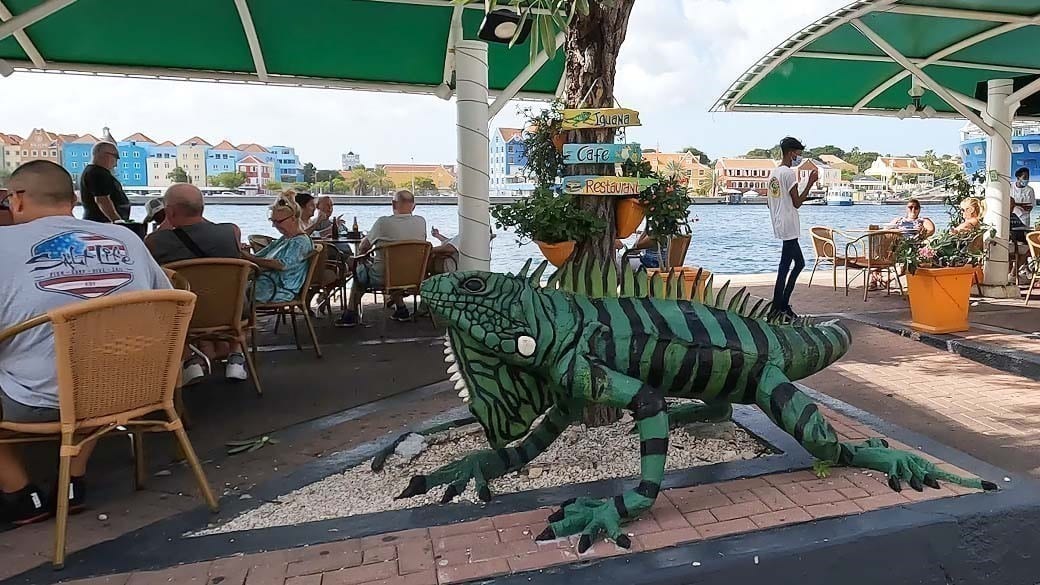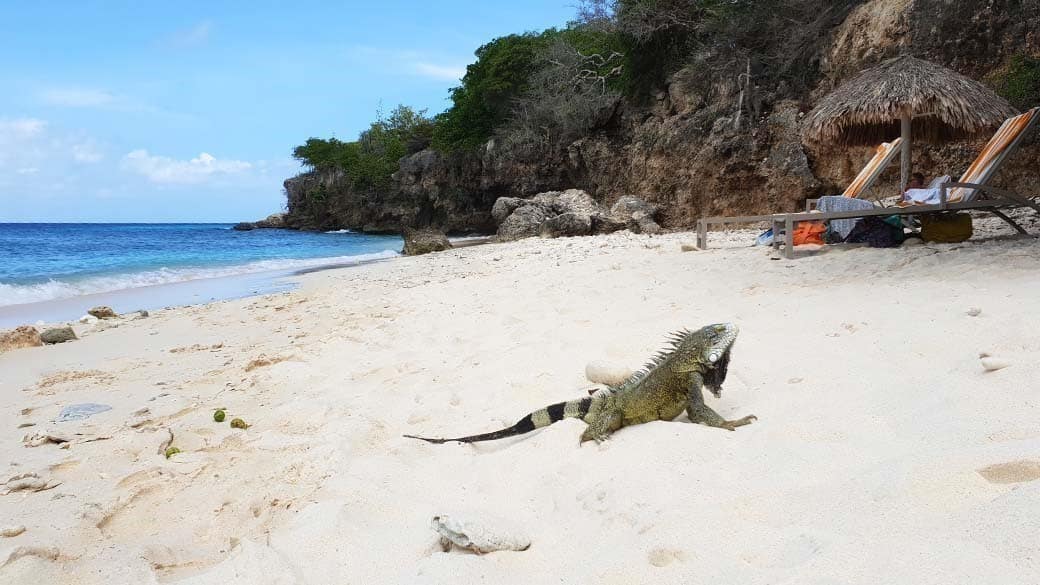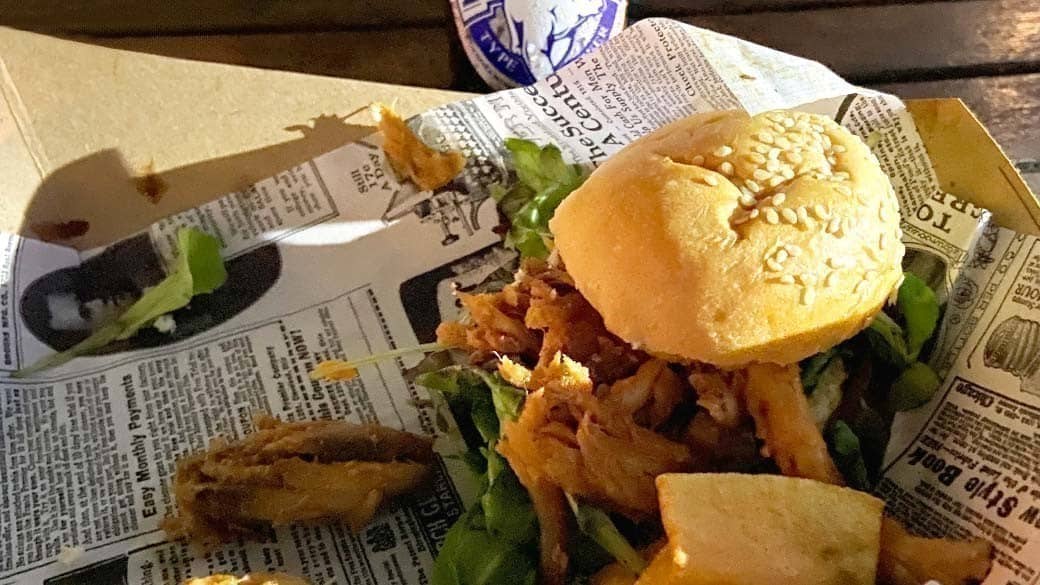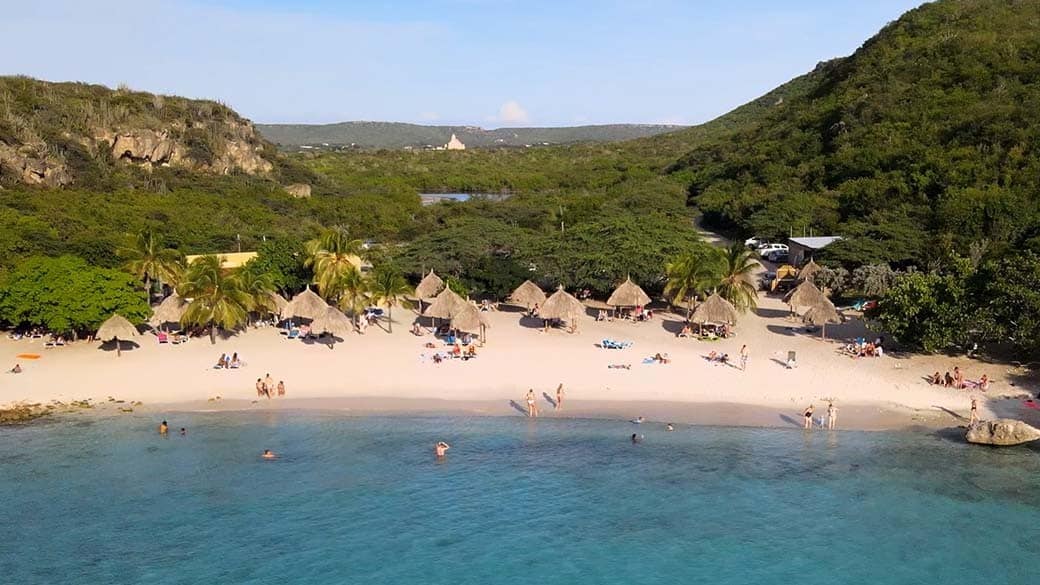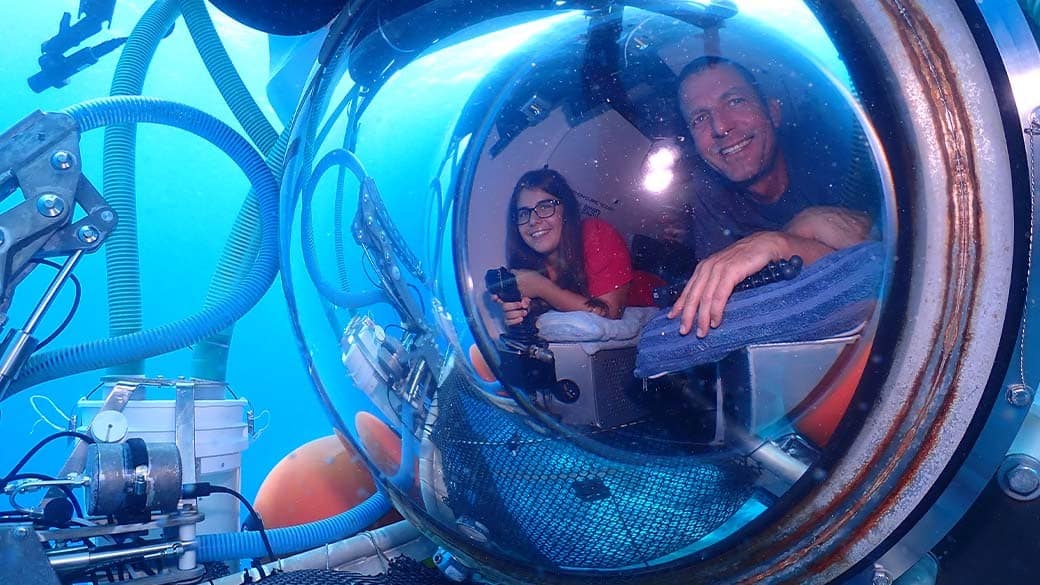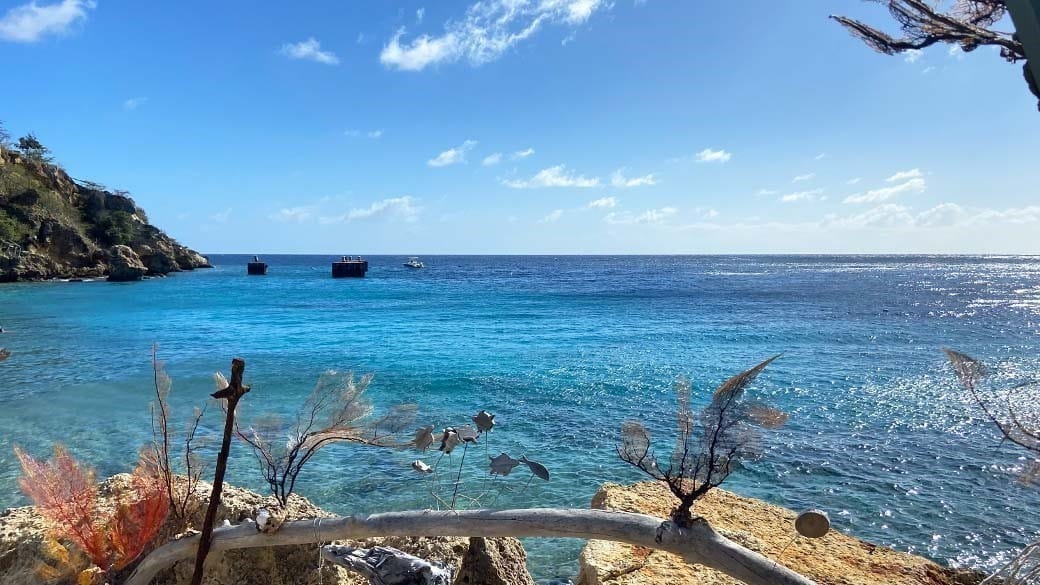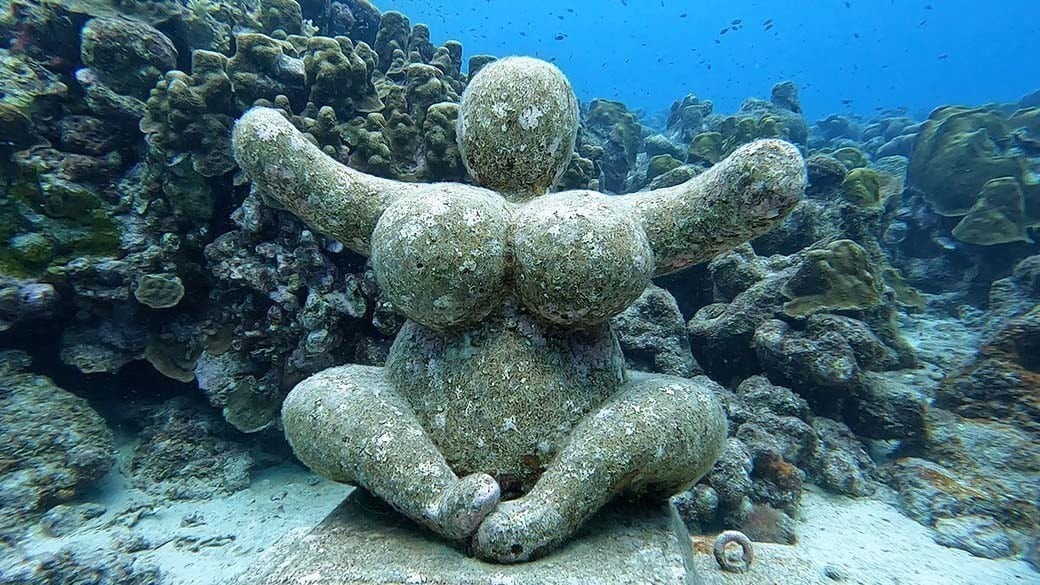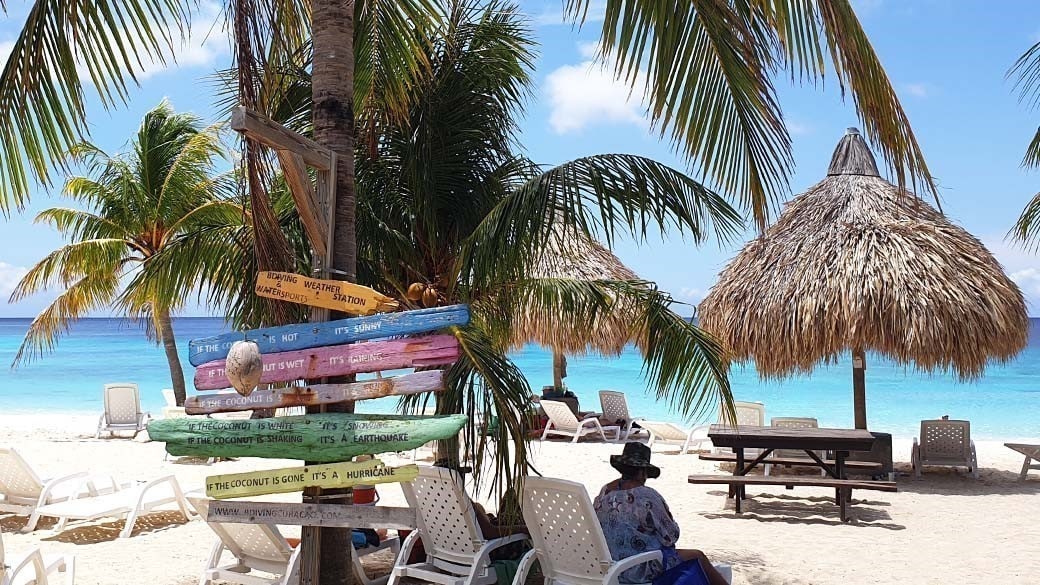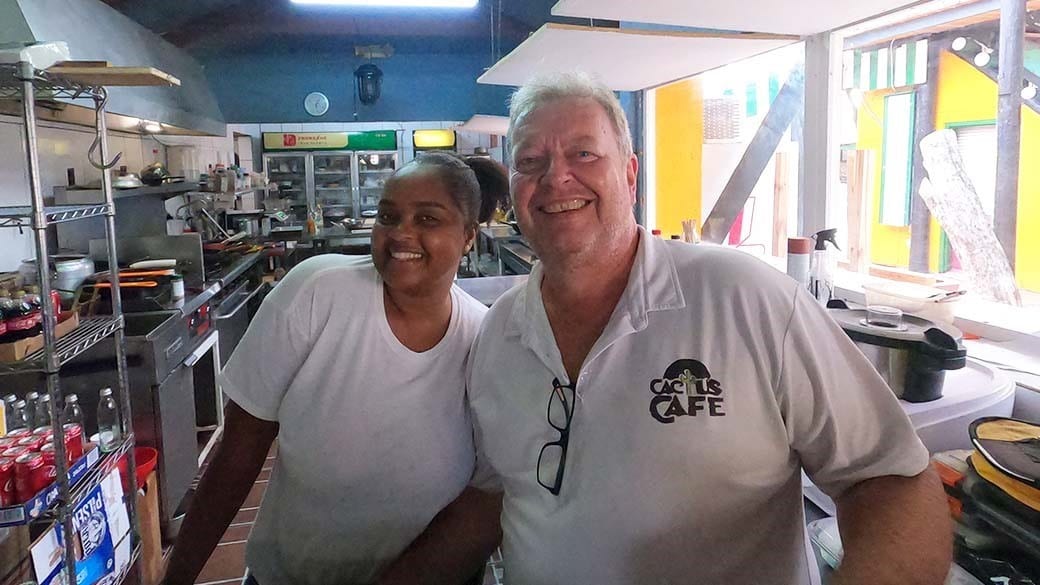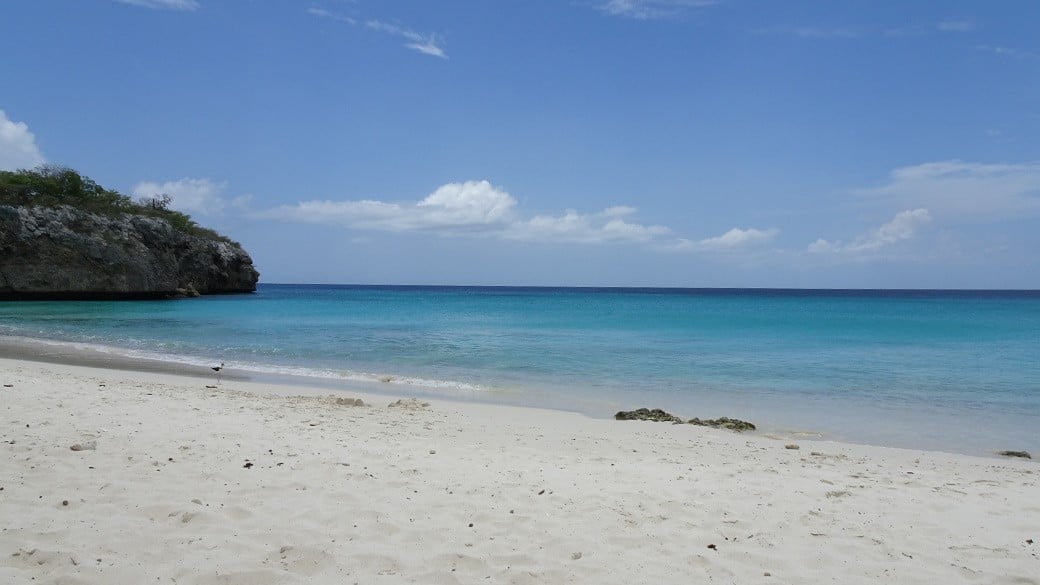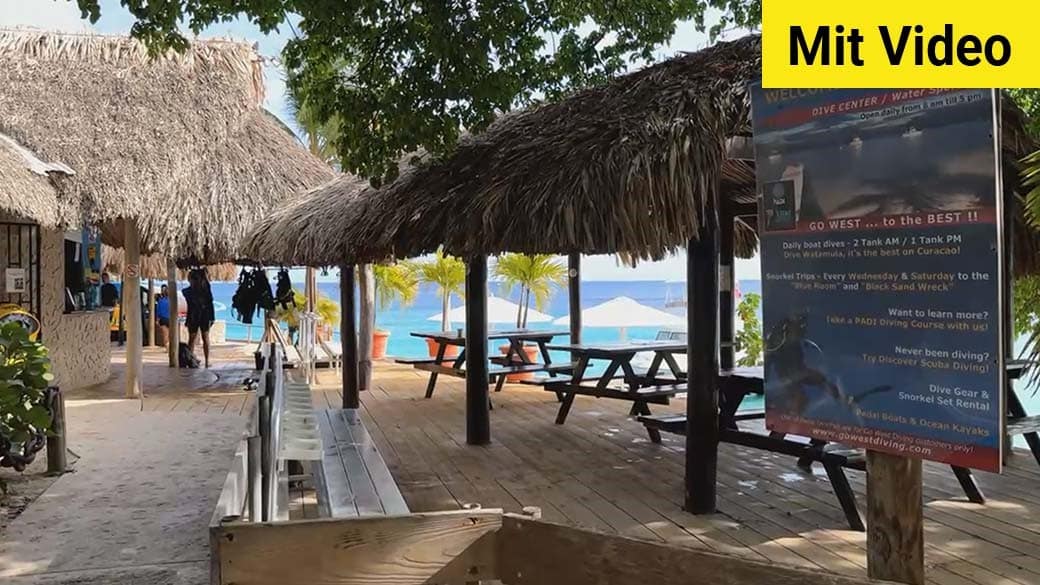Iguana
Green iguana named Yuana
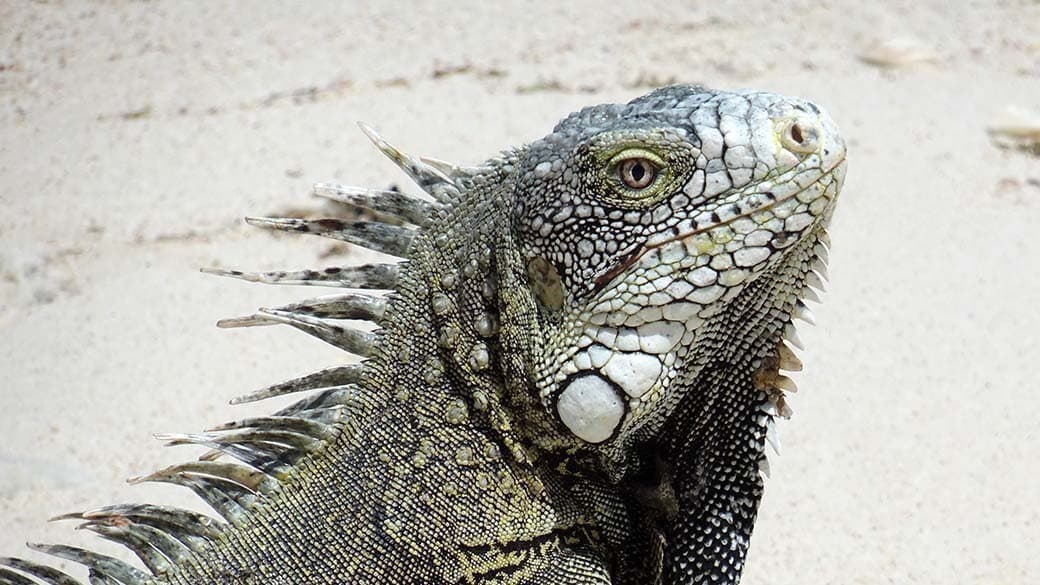
The Doppler Iguana Iguana in the name of Curacao's green iguana is basically correct. That's the scientific name of the reptile we're talking about here. Curacao's inhabitants call it Yuana bèrdè, whereby the Papiamentu word 'bèrdè' translates as 'green'. 'Yuana' is a variation of "Iwana" which comes from Taíno, the language of the indigenous people of Curacao.
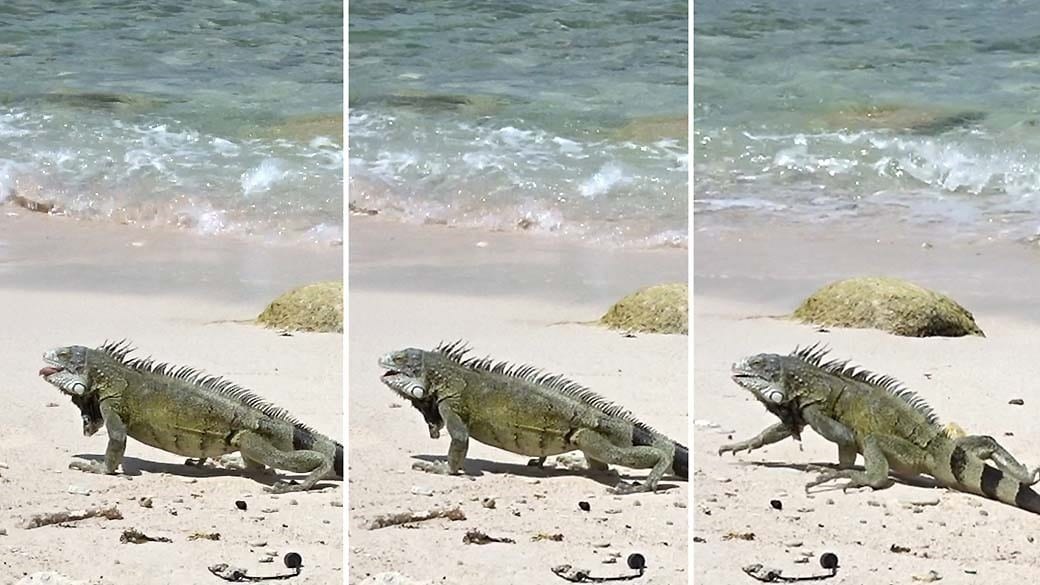
This candidate seems to have fun on the beach
Iguanas everywhere
On Curacao, the iguana is your constant companion, whether on the streets, in the middle of the city, on walls, sidewalks or even on the beach. You can't miss these dragon-like animals, as they are up to 1.5 meters long, although their striped tail makes up around 2/3 of their body length. They may look dangerous, but they are completely harmless.
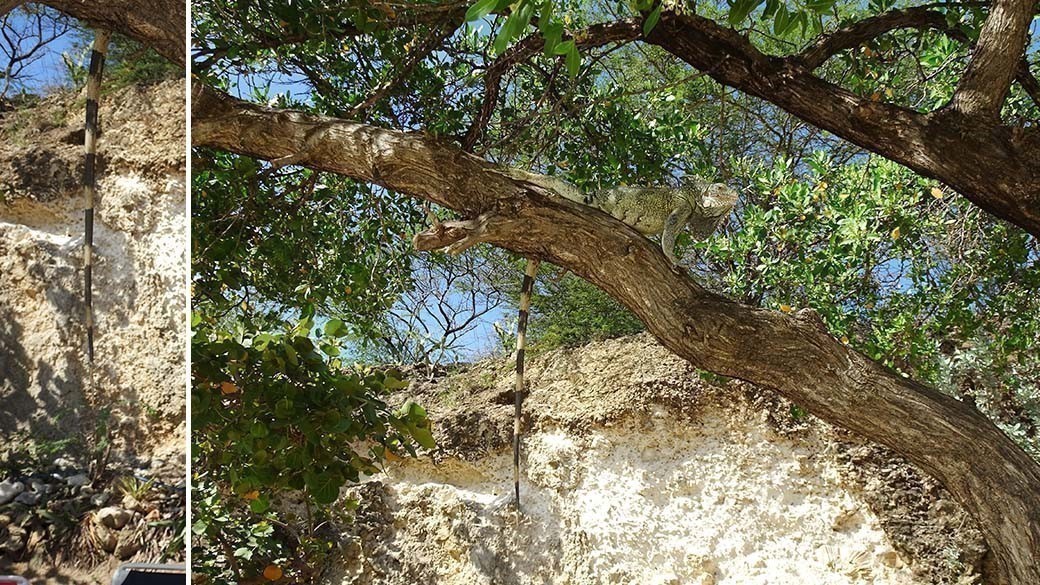
Not a snake, but the tail of an iguana
The diurnal large lizards are cold-blooded animals. They obtain their body temperature from the ambient heat. This is why iguanas like to lie in the sun. They often sunbathe on the warm asphalt of roads or on sidewalks to keep warm.
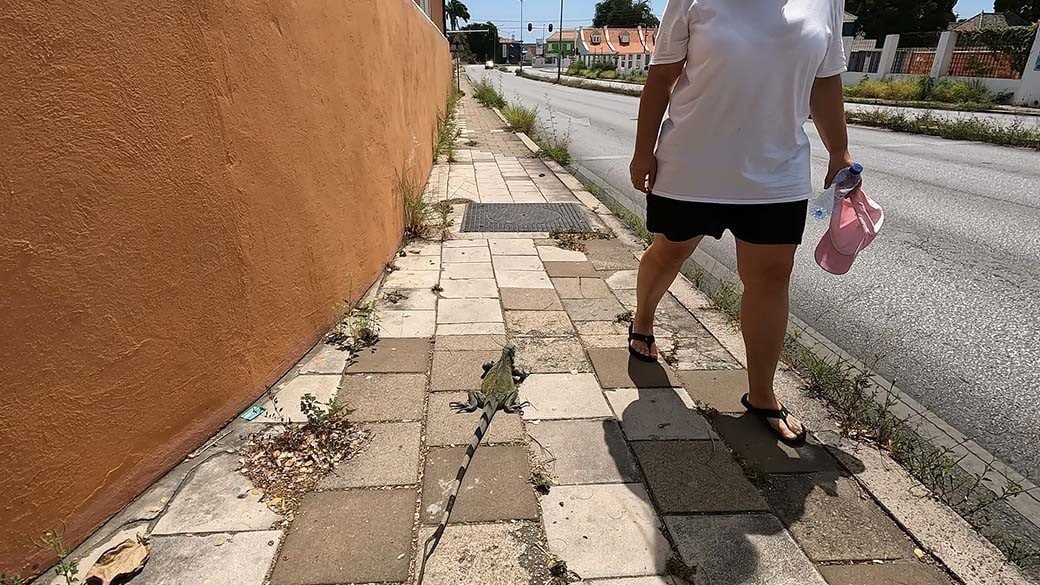
This one doesn't let me bother him at all
The reptiles mainly live in and on trees. Their green to grey-brown scales are perfect for camouflage. With their long, sharp claws, the iguanas are true climbing artists, which has earned them the nickname of tree chicken – galiña di palu (palu=tree, galinha=chicken in Portuguese). The term "green chicken" is often used in connection with the iguana – this is how it is called as a dish.
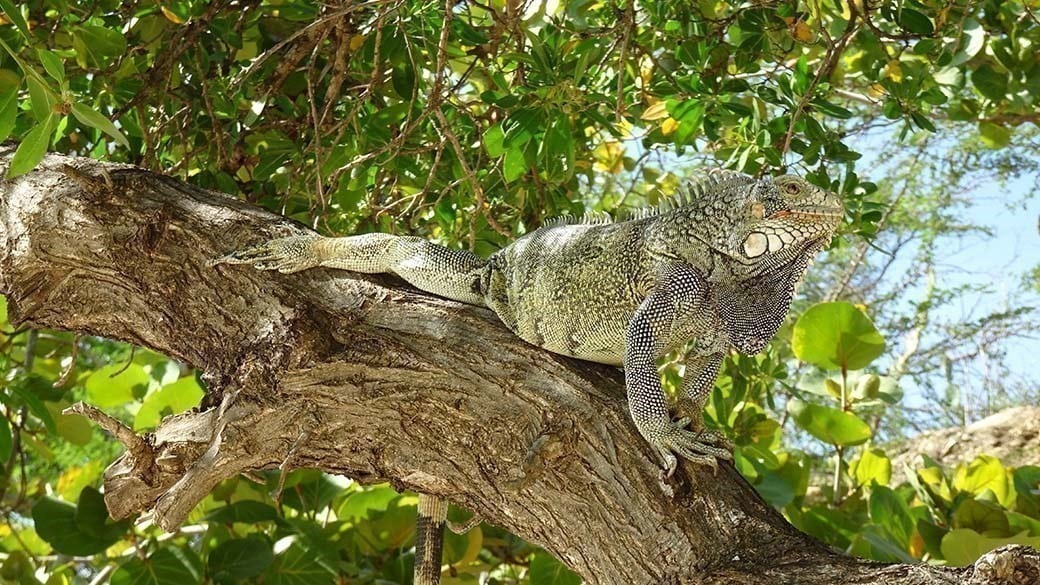
Iguana, the green chicken of the tree
Iguana as food?
Yep, you read that right. Iguana is often on the menu in Curacao's restaurants. This is especially the case in restaurants with local food, like Jaanchie's in Westpunt or at the old market Plasa Bieu. In local cuisine, iguana meat is used in soups or in the famous stews known as stobas, which are also available with goat meat, beef or vegetarian papaya.
We got a sample of iguana on a 4th of July in Barber. We remember the date so well because, as luck would have it, we met up with friends at the 4th of July Bar that day. It felt like half of Curacao had gathered there: razzle-dazzle with DJane and an open-air party. As we sat together over a beer, someone bought us a round of burgers. They were iguana burgers, which we couldn't possibly refuse. We were also curious to find out what green iguana tastes like.
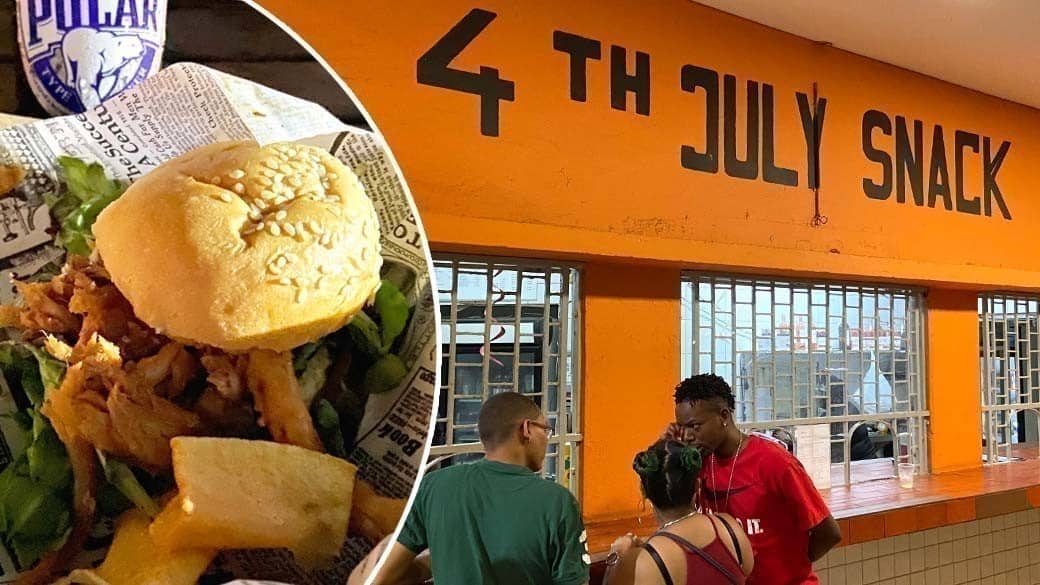
Iguana burger at the snack bar
And this is where the 'Grünes Hendl', as we Bavarians call chicken, comes into play: It actually resembles chicken meat in consistency and taste. It is light-colored meat, which in my opinion is a little more firm to the bite than chicken. However, you have to enjoy it carefully, as iguana meat contains lots of fine bones, similar to fish bones. Overall, the iguana burger tasted good.
Aftertaste
Nevertheless, I wouldn't order or eat green iguana again. I feel kind of sorry for him.
Friends of ours told us about an experience from their vacation on Curacao. During a break at the side of the road next to the rental car, two guys with hunting rifles suddenly emerged from the thorny bushes. Completely spooked, our friends dared to ask what was going on. The answer was that they had nothing to fear, they were "only" hunting iguana.
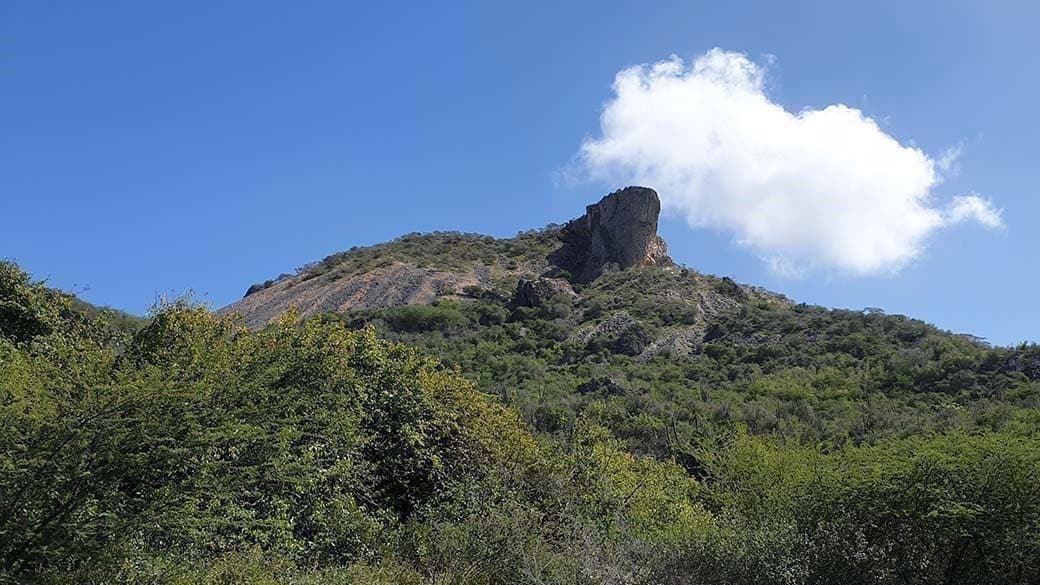
On the way to Santa Barbara there is a rock shaped like an iguana
We also heard that many people on Curacao were struggling economically during the pandemic because many tourists stayed away. So, people switched to eating iguana, as it was available for free everywhere on the island. As a result, the population of iguanas was reduced so much that hunting them was banned pretty soon after. We don't know what the situation is today and whether the population has completely recovered.
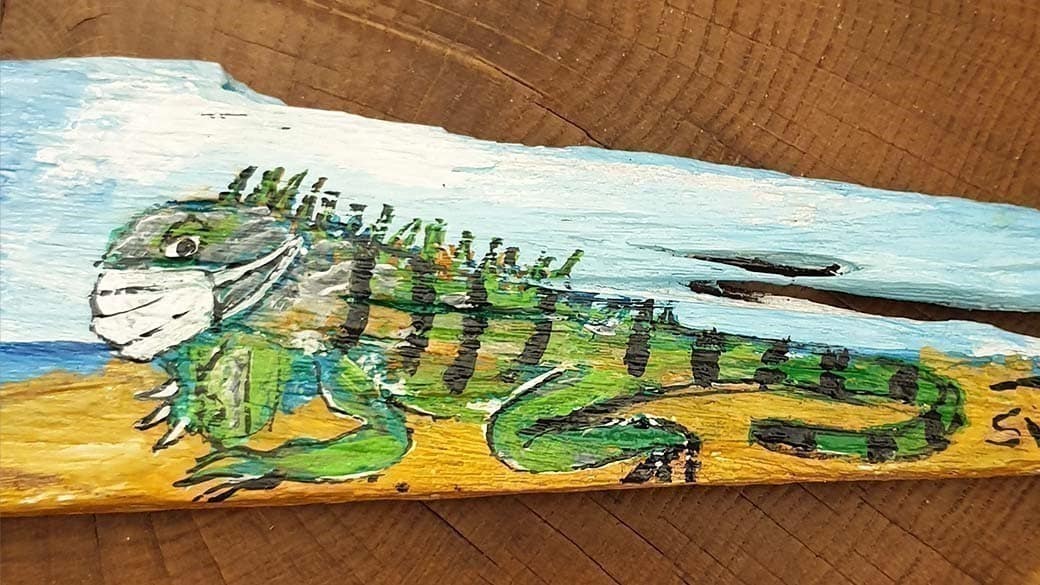
Beach-sign by Shirley Wimpel
How to train your dragon
There was a guy in Curacao, now deceased, who used to tame iguanas. He was known everywhere as the 'Iguana Man' and even made it onto the Wikipedia page about yuana (Infromashon general) as the man who walks his iguanas in Punda.
We met the iguana man years ago. Miraculously, his yuanas always stayed with him – without a leash. Although iguanas aren't poisonous or wild dragons like Komodo dragons, they're not really comparable to tame pets.
It was our first close encounter with green iguanas. Before that, we had only ever seen them from a distance and weren't familiar with their behavior. When we started talking to the iguana man about feeding his iguanas, things got moving. Before we knew it, he was draping the two iguanas on our daughters one after the other – even on their heads. He encouraged us to take pictures. Knowing that this 'nice gesture' was not for nothing, we agreed on a fee for the photos. However, he then wanted much more than we had originally agreed.
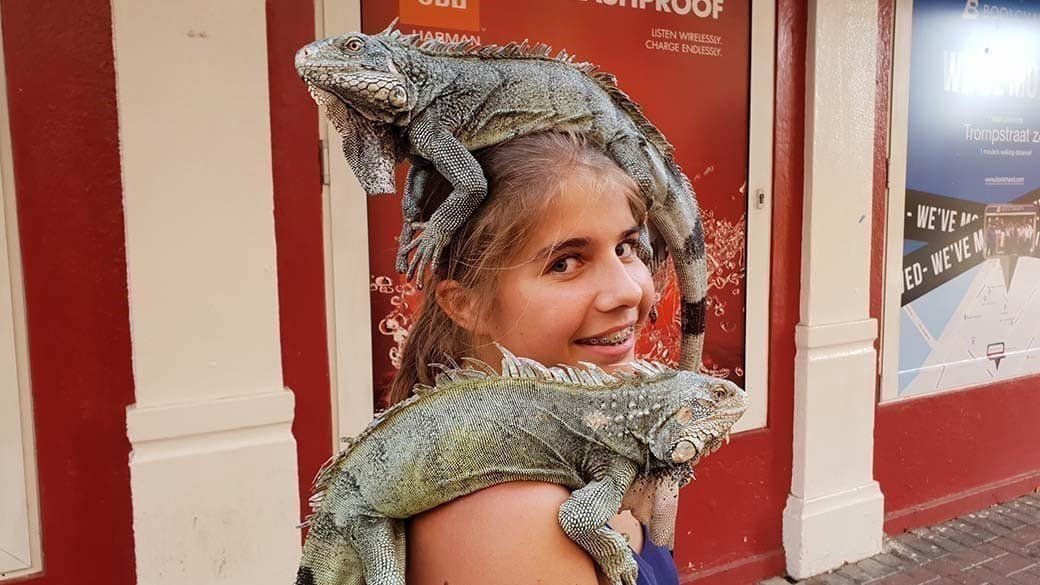
The two iguanas from 'Iguana Man'
After refusing to pay more, we were insulted by him in the street and left disappointed. That was our very personal experience with the Iguana Man.
I read in the Curacao Visitors Forum that the Iguana Man is said to have been very hospitable and even invited tourists to his home. So there are many different memories of this man. May he rest in peace!
The Iguana as a landmark
In Curacao, for example, there is a traffic circle with a huge shiny silver metal iguana. Stefan and I always refer to this landmark on the way to Westpunt as the Iguana traffic circle. When we tell others about the Iguana traffic circle, everyone immediately knows which corner of the island we are talking about.
In the middle of Punda, on Wilhelminaplein, where you can see the letters DUSHI and CURACAO, you will find large, green plastic iguanas. They're in the playground and kids love to climb on them.
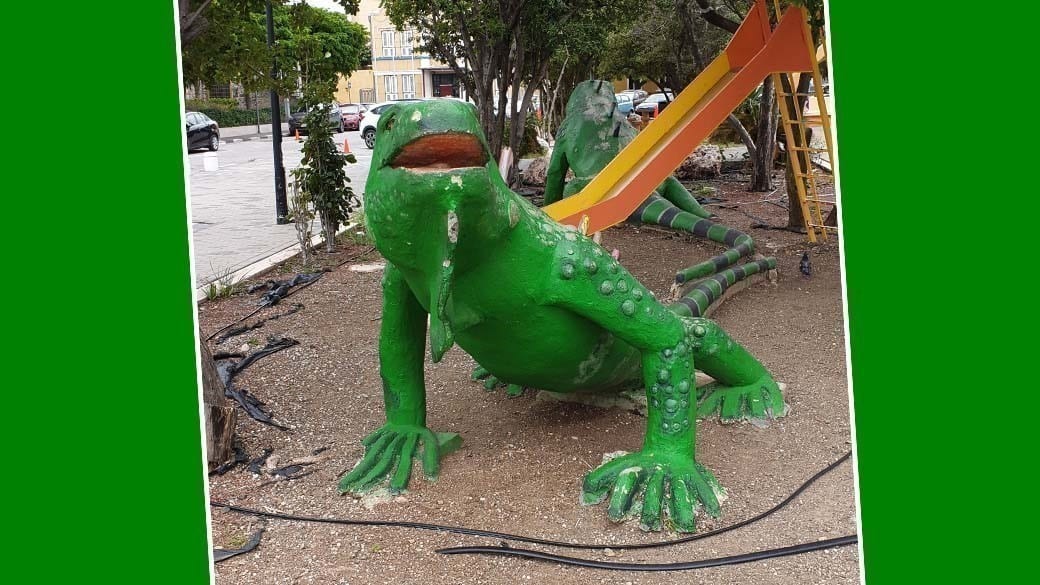
Green iguanas in the playground at Wilhelminaplein
The Iguana Café in Punda is also named after the green iguana. The restaurant is located next to the Punda Love Hearts, right on the quay of the Sint Annabaai. There's a green and black striped specimen sitting under the awnings, which spray water vapor intermittently. It's a great place to be when the temperature is around 30° C. You can watch the shipping traffic and the Queen Emma Bridge, which keeps moving completely to one side again and again. Hardly impossible to get bored! You can also buy the hip T-shirts with a unusual iguana design that the waiters wear here. A souvenir tip for T-shirt collectors!
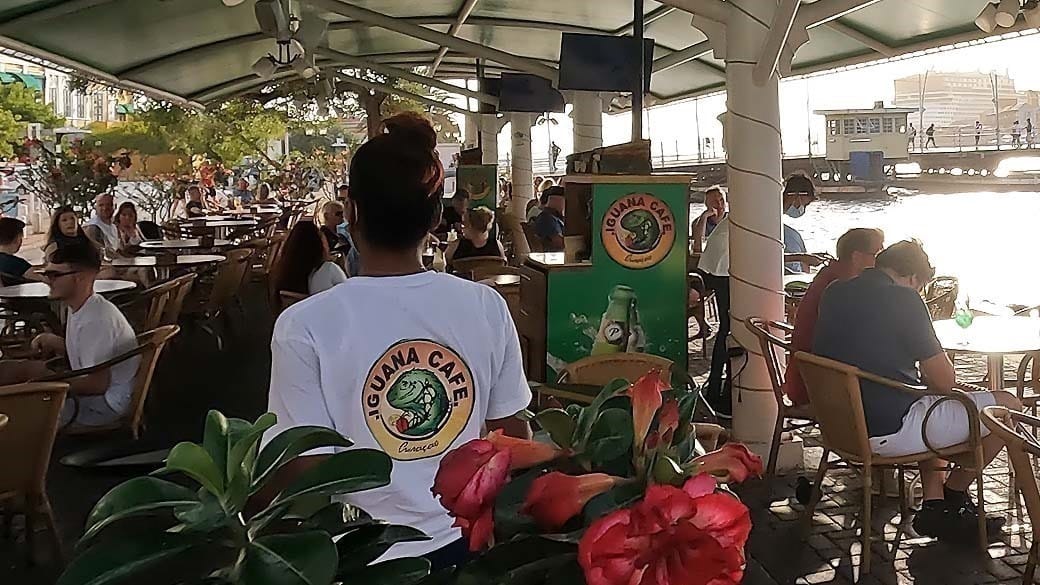
Iguana Café in Punda
Cruising through the city with Iguana Ride
The Iguana is also the inspiration for a cool business idea. Our buddy Pablo offers adventure tours on e-scooters as 'Iguana Ride'. We spent a day on the road with him. You can watch the short and the longer video on YouTube. The e-scooter article can be found here.
When we wrapped up the day at Zus di Plaza, we talked about the taste of Iguana:
The iguana's diet
Even though we humans eat iguanas, the iguanas themselves feed exclusively on plants. Apparently, it has already been observed that young iguanas eat protein injections in the form of insects. Normally, however, adult iguanas like fruit and vegetables such as fruit, seeds and flowers. This is a problem for some farmers and hobby gardeners who mourn the loss of flowers or have to share their mangos on the trees with iguanas.

This frangipani thief climbs up to the outermost flower
The iguana is not that green
But yes, it is, namely as juvenile. Over time, the vibrant green color fades more and more through numerous molts, so that the adult reptiles take on an olive to ash green or grey-brown color. A Yuana baby is called 'Shilip', an old animal 'Barbachi'.

It's even less green after moulting
A question of posture
The pangolins don't make loud noises. They communicate through body language such as nodding their heads or puffing out their throat folds to threaten or show dominance. In this way, they try to impress the somewhat less massive females. Adult males can be distinguished by their broader head and the enlarged scales under the eardrum as well as the much higher, dragon-like dorsal crest.
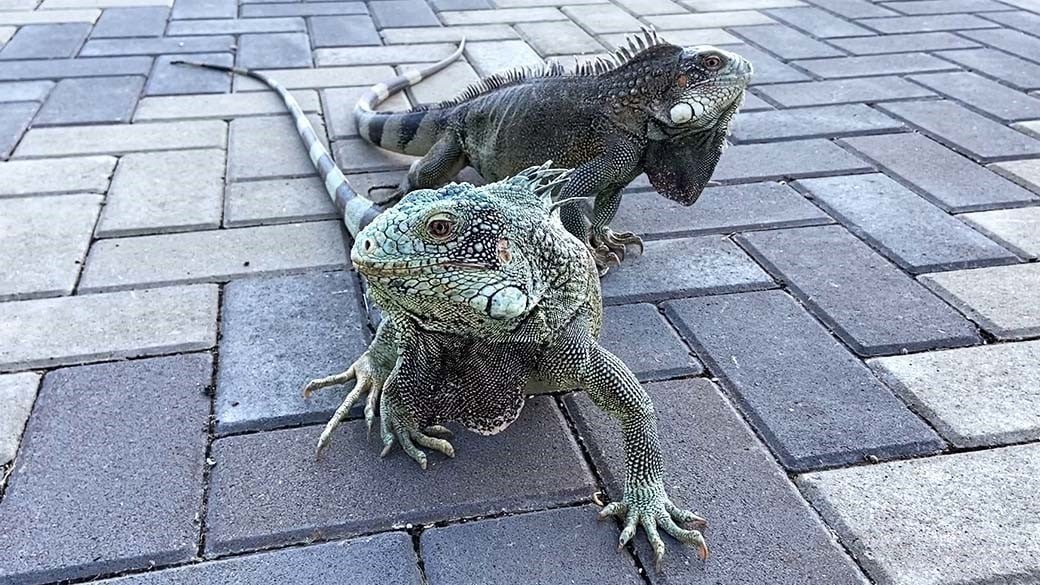
Male in front, female in back
Offense is the best or last defense of iguanas
If you corner an iguana, it can bite, scratch and lash out with its tail. They can shed their tails, but they won't grow back to their original size.
Iguanas have long since shed their shyness towards humans, especially on Curacao. They have few natural enemies, except perhaps birds of prey. These include the Wara Wara, which in turn clears the streets of iguanas that have been run over.
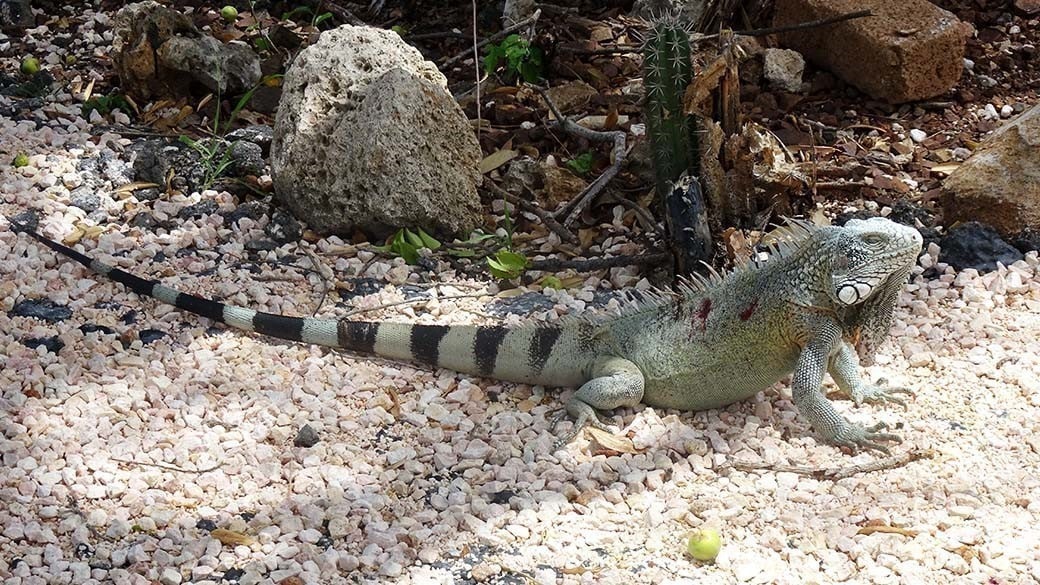
An iguana with battle scars on its back
House dragon
Iguanas are location-loyal animals. The mini-dragons are welcome guests. Many hotels have their "house iguanas" which live there and wait for something to drop from the breakfast buffet for them. The Kokomo Beach, for example, even has its own iguana feeding station next to the restaurant.
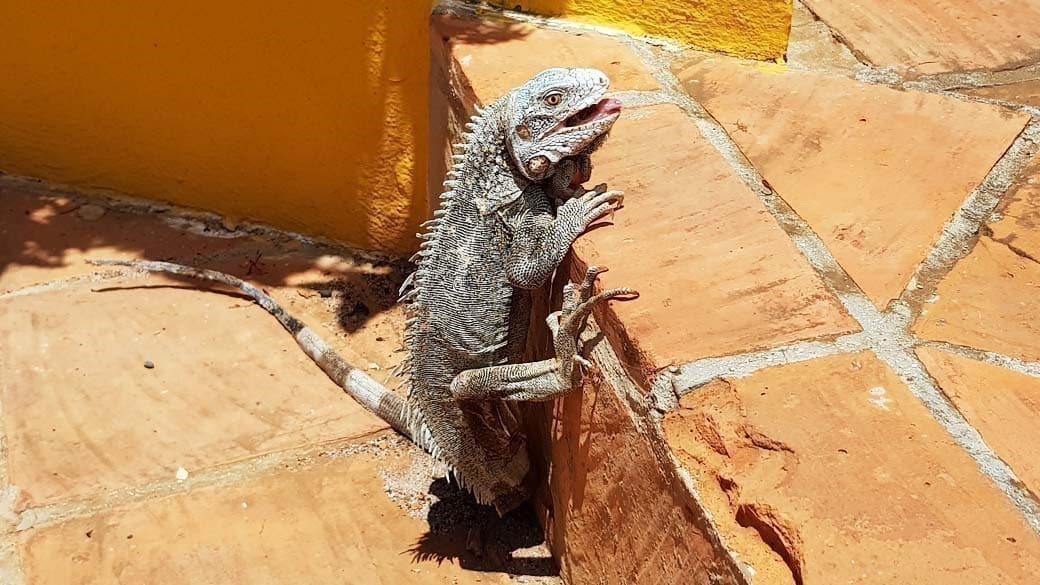
Iguana at All West Apartments
Our friends were doomed by the habit and site loyalty of a house iguana: not so cool, because every day he pooped in their pool. 😱
Another interesting fact is that iguanas are good swimmers. When fleeing, they sometimes drop into the water from overhanging branches to escape the threat of a cat, for example. This is why they don't mind being close to the water on Curacao's beaches. Iguanas even have a kind of symbiotic relationship with the toxic manzanilla tree. They like to snack on its fruits, which are also known as the 'apples of death'. Because what is poison for one is food for the other.
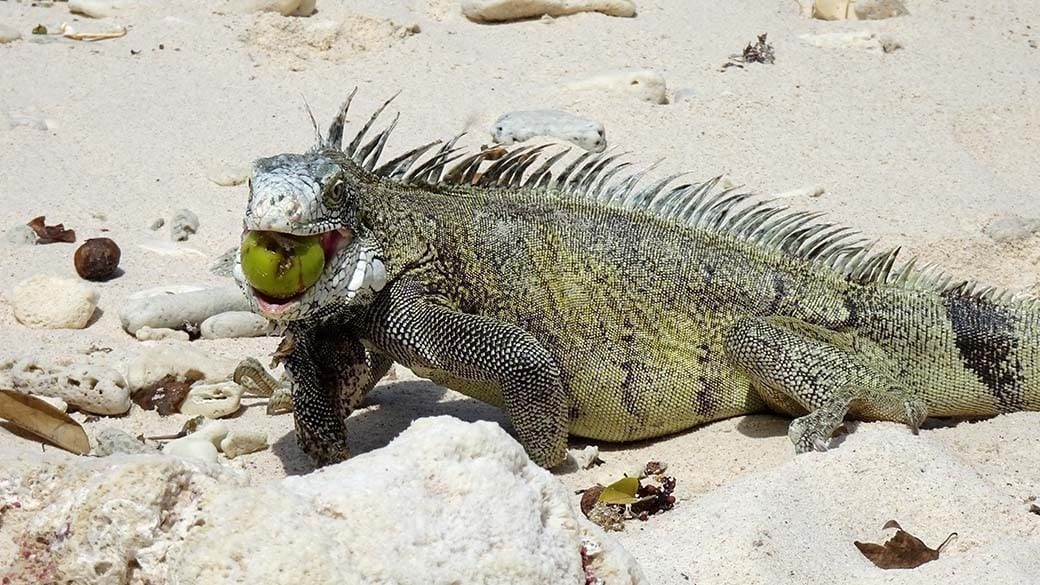
The beach apple is a tasty treat for iguanas
Some of the vegans can be hand-fed with fruit. Touching or stroking is sometimes accepted, but not enjoyed, because reptiles aren't cuddly animals. If you want to eat undisturbed by iguanas in your vacation home, you should not feed them. There is a special sign in the Whitehouse in Lagun:
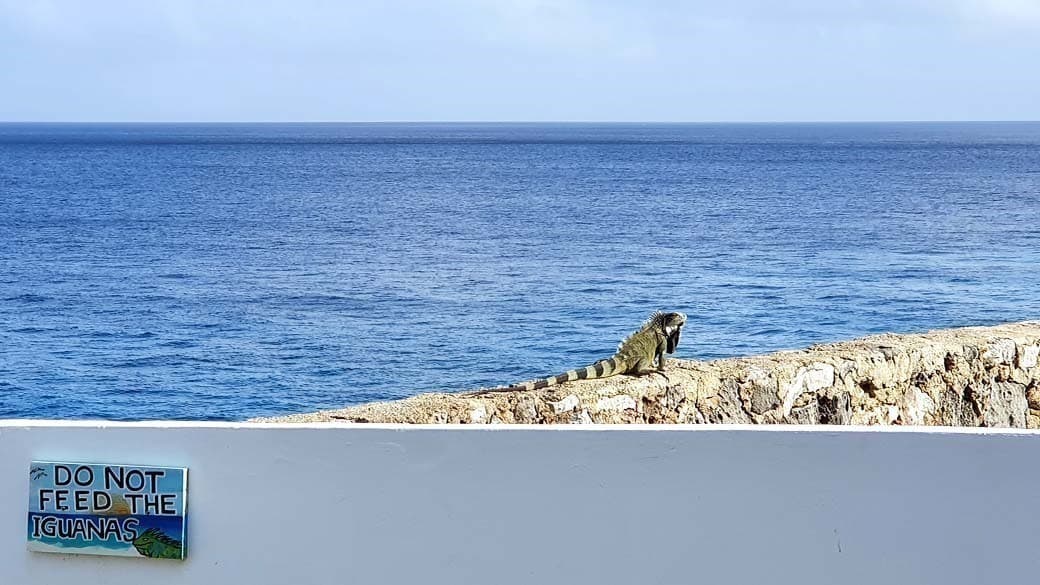
And here is a short video about the two house dragons from the Whitehouse:
Do you know the answer? We collected 100+ entertaining questions about Curacao. Have fun!
Quiz Question
Which lettering is displayed in oversize on Wilhelminaplein?Answer
CURACAO and DUSHI – the postcard motifs par excellence.
The lettering can be used wonderfully for a souvenir photo if you pose creatively within the letters.
The Papiamentu word DUSHI is probably the most frequently used word on Curacao. Find out more in our article about the local language Papiamentu.
Do you like more? Here is another post you might be interested in:
If you enjoyed this article, we would be very happy if you share it with your friends on social media. Thank you very much!
Fancy the sea? In our Beaches and Snorkeling & Diving sections, your vacation dreams will come true. In the Lifestyle section, we tell you about the colorful Caribbean way of life. You'll find culinary delights in Restaurants & Bars and in Shopping we show you where you can find great and affordable deals. Wanna an insider tip? Pssst – click quietly!
Iguana
Green iguana named Yuana

The Doppler Iguana Iguana in the name of Curacao's green iguana is basically correct. That's the scientific name of the reptile we're talking about here. Curacao's inhabitants call it Yuana bèrdè, whereby the Papiamentu word 'bèrdè' translates as 'green'. 'Yuana' is a variation of "Iwana" which comes from Taíno, the language of the indigenous people of Curacao.

This candidate seems to have fun on the beach
Iguanas everywhere
On Curacao, the iguana is your constant companion, whether on the streets, in the middle of the city, on walls, sidewalks or even on the beach. You can't miss these dragon-like animals, as they are up to 1.5 meters long, although their striped tail makes up around 2/3 of their body length. They may look dangerous, but they are completely harmless.

Not a snake, but the tail of an iguana
The diurnal large lizards are cold-blooded animals. They obtain their body temperature from the ambient heat. This is why iguanas like to lie in the sun. They often sunbathe on the warm asphalt of roads or on sidewalks to keep warm.

This one doesn't let me bother him at all
The reptiles mainly live in and on trees. Their green to grey-brown scales are perfect for camouflage. With their long, sharp claws, the iguanas are true climbing artists, which has earned them the nickname of tree chicken – galiña di palu (palu=tree, galinha=chicken in Portuguese). The term "green chicken" is often used in connection with the iguana – this is how it is called as a dish.

Iguana, the green chicken of the tree
Iguana as food?
Yep, you read that right. Iguana is often on the menu in Curacao's restaurants. This is especially the case in restaurants with local food, like Jaanchie's in Westpunt or at the old market Plasa Bieu. In local cuisine, iguana meat is used in soups or in the famous stews known as stobas, which are also available with goat meat, beef or vegetarian papaya.
We got a sample of iguana on a 4th of July in Barber. We remember the date so well because, as luck would have it, we met up with friends at the 4th of July Bar that day. It felt like half of Curacao had gathered there: razzle-dazzle with DJane and an open-air party. As we sat together over a beer, someone bought us a round of burgers. They were iguana burgers, which we couldn't possibly refuse. We were also curious to find out what green iguana tastes like.

Iguana burger at the snack bar
And this is where the 'Grünes Hendl', as we Bavarians call chicken, comes into play: It actually resembles chicken meat in consistency and taste. It is light-colored meat, which in my opinion is a little more firm to the bite than chicken. However, you have to enjoy it carefully, as iguana meat contains lots of fine bones, similar to fish bones. Overall, the iguana burger tasted good.
Aftertaste
Nevertheless, I wouldn't order or eat green iguana again. I feel kind of sorry for him.
Friends of ours told us about an experience from their vacation on Curacao. During a break at the side of the road next to the rental car, two guys with hunting rifles suddenly emerged from the thorny bushes. Completely spooked, our friends dared to ask what was going on. The answer was that they had nothing to fear, they were "only" hunting iguana.

On the way to Santa Barbara there is a rock shaped like an iguana
We also heard that many people on Curacao were struggling economically during the pandemic because many tourists stayed away. So, people switched to eating iguana, as it was available for free everywhere on the island. As a result, the population of iguanas was reduced so much that hunting them was banned pretty soon after. We don't know what the situation is today and whether the population has completely recovered.

Beach-sign by Shirley Wimpel
How to train your dragon
There was a guy in Curacao, now deceased, who used to tame iguanas. He was known everywhere as the 'Iguana Man' and even made it onto the Wikipedia page about yuana (Infromashon general) as the man who walks his iguanas in Punda.
We met the iguana man years ago. Miraculously, his yuanas always stayed with him – without a leash. Although iguanas aren't poisonous or wild dragons like Komodo dragons, they're not really comparable to tame pets.
It was our first close encounter with green iguanas. Before that, we had only ever seen them from a distance and weren't familiar with their behavior. When we started talking to the iguana man about feeding his iguanas, things got moving. Before we knew it, he was draping the two iguanas on our daughters one after the other – even on their heads. He encouraged us to take pictures. Knowing that this 'nice gesture' was not for nothing, we agreed on a fee for the photos. However, he then wanted much more than we had originally agreed.

The two iguanas from 'Iguana Man'
After refusing to pay more, we were insulted by him in the street and left disappointed. That was our very personal experience with the Iguana Man.
I read in the Curacao Visitors Forum that the Iguana Man is said to have been very hospitable and even invited tourists to his home. So there are many different memories of this man. May he rest in peace!
The Iguana as a landmark
In Curacao, for example, there is a traffic circle with a huge shiny silver metal iguana. Stefan and I always refer to this landmark on the way to Westpunt as the Iguana traffic circle. When we tell others about the Iguana traffic circle, everyone immediately knows which corner of the island we are talking about.
In the middle of Punda, on Wilhelminaplein, where you can see the letters DUSHI and CURACAO, you will find large, green plastic iguanas. They're in the playground and kids love to climb on them.

Green iguanas in the playground at Wilhelminaplein
The Iguana Café in Punda is also named after the green iguana. The restaurant is located next to the Punda Love Hearts, right on the quay of the Sint Annabaai. There's a green and black striped specimen sitting under the awnings, which spray water vapor intermittently. It's a great place to be when the temperature is around 30° C. You can watch the shipping traffic and the Queen Emma Bridge, which keeps moving completely to one side again and again. Hardly impossible to get bored! You can also buy the hip T-shirts with a unusual iguana design that the waiters wear here. A souvenir tip for T-shirt collectors!

Iguana Café in Punda
Cruising through the city with Iguana Ride
The Iguana is also the inspiration for a cool business idea. Our buddy Pablo offers adventure tours on e-scooters as 'Iguana Ride'. We spent a day on the road with him. You can watch the short and the longer video on YouTube. The e-scooter article can be found here.
When we wrapped up the day at Zus di Plaza, we talked about the taste of Iguana:
The iguana's diet
Even though we humans eat iguanas, the iguanas themselves feed exclusively on plants. Apparently, it has already been observed that young iguanas eat protein injections in the form of insects. Normally, however, adult iguanas like fruit and vegetables such as fruit, seeds and flowers. This is a problem for some farmers and hobby gardeners who mourn the loss of flowers or have to share their mangos on the trees with iguanas.

This frangipani thief climbs up to the outermost flower
The iguana is not that green
But yes, it is, namely as juvenile. Over time, the vibrant green color fades more and more through numerous molts, so that the adult reptiles take on an olive to ash green or grey-brown color. A Yuana baby is called 'Shilip', an old animal 'Barbachi'.

It's even less green after moulting
A question of posture
The pangolins don't make loud noises. They communicate through body language such as nodding their heads or puffing out their throat folds to threaten or show dominance. In this way, they try to impress the somewhat less massive females. Adult males can be distinguished by their broader head and the enlarged scales under the eardrum as well as the much higher, dragon-like dorsal crest.

Male in front, female in back
Offense is the best or last defense of iguanas
If you corner an iguana, it can bite, scratch and lash out with its tail. They can shed their tails, but they won't grow back to their original size.
Iguanas have long since shed their shyness towards humans, especially on Curacao. They have few natural enemies, except perhaps birds of prey. These include the Wara Wara, which in turn clears the streets of iguanas that have been run over.

An iguana with battle scars on its back
House dragon
Iguanas are location-loyal animals. The mini-dragons are welcome guests. Many hotels have their "house iguanas" which live there and wait for something to drop from the breakfast buffet for them. The Kokomo Beach, for example, even has its own iguana feeding station next to the restaurant.

Iguana at All West Apartments
Our friends were doomed by the habit and site loyalty of a house iguana: not so cool, because every day he pooped in their pool. 😱
Another interesting fact is that iguanas are good swimmers. When fleeing, they sometimes drop into the water from overhanging branches to escape the threat of a cat, for example. This is why they don't mind being close to the water on Curacao's beaches. Iguanas even have a kind of symbiotic relationship with the toxic manzanilla tree. They like to snack on its fruits, which are also known as the 'apples of death'. Because what is poison for one is food for the other.

The beach apple is a tasty treat for iguanas
Some of the vegans can be hand-fed with fruit. Touching or stroking is sometimes accepted, but not enjoyed, because reptiles aren't cuddly animals. If you want to eat undisturbed by iguanas in your vacation home, you should not feed them. There is a special sign in the Whitehouse in Lagun:

And here is a short video about the two house dragons from the Whitehouse:
Other articles from the "Nature" category that might interest you:
If you enjoyed this article, we would be very happy if you share it with your friends on social media. Thank you very much!
Leave A Comment
Recommended readings from other categories:
Quiz Question
Which lettering is displayed in oversize on Wilhelminaplein?Answer
CURACAO and DUSHI – the postcard motifs par excellence.
The lettering can be used wonderfully for a souvenir photo if you pose creatively within the letters.
The Papiamentu word DUSHI is probably the most frequently used word on Curacao. Find out more in our article about the local language Papiamentu.
#withus - our articles at your fingertips on a common map - try it!
Iguana
Green iguana named Yuana

The Doppler Iguana Iguana in the name of Curacao's green iguana is basically correct. That's the scientific name of the reptile we're talking about here. Curacao's inhabitants call it Yuana bèrdè, whereby the Papiamentu word 'bèrdè' translates as 'green'. 'Yuana' is a variation of "Iwana" which comes from Taíno, the language of the indigenous people of Curacao.

This candidate seems to have fun on the beach
Iguanas everywhere
On Curacao, the iguana is your constant companion, whether on the streets, in the middle of the city, on walls, sidewalks or even on the beach. You can't miss these dragon-like animals, as they are up to 1.5 meters long, although their striped tail makes up around 2/3 of their body length. They may look dangerous, but they are completely harmless.

Not a snake, but the tail of an iguana
The diurnal large lizards are cold-blooded animals. They obtain their body temperature from the ambient heat. This is why iguanas like to lie in the sun. They often sunbathe on the warm asphalt of roads or on sidewalks to keep warm.

This one doesn't let me bother him at all
The reptiles mainly live in and on trees. Their green to grey-brown scales are perfect for camouflage. With their long, sharp claws, the iguanas are true climbing artists, which has earned them the nickname of tree chicken – galiña di palu (palu=tree, galinha=chicken in Portuguese). The term "green chicken" is often used in connection with the iguana – this is how it is called as a dish.

Iguana, the green chicken of the tree
Iguana as food?
Yep, you read that right. Iguana is often on the menu in Curacao's restaurants. This is especially the case in restaurants with local food, like Jaanchie's in Westpunt or at the old market Plasa Bieu. In local cuisine, iguana meat is used in soups or in the famous stews known as stobas, which are also available with goat meat, beef or vegetarian papaya.
We got a sample of iguana on a 4th of July in Barber. We remember the date so well because, as luck would have it, we met up with friends at the 4th of July Bar that day. It felt like half of Curacao had gathered there: razzle-dazzle with DJane and an open-air party. As we sat together over a beer, someone bought us a round of burgers. They were iguana burgers, which we couldn't possibly refuse. We were also curious to find out what green iguana tastes like.

Iguana burger at the snack bar
And this is where the 'Grünes Hendl', as we Bavarians call chicken, comes into play: It actually resembles chicken meat in consistency and taste. It is light-colored meat, which in my opinion is a little more firm to the bite than chicken. However, you have to enjoy it carefully, as iguana meat contains lots of fine bones, similar to fish bones. Overall, the iguana burger tasted good.
Aftertaste
Nevertheless, I wouldn't order or eat green iguana again. I feel kind of sorry for him.
Friends of ours told us about an experience from their vacation on Curacao. During a break at the side of the road next to the rental car, two guys with hunting rifles suddenly emerged from the thorny bushes. Completely spooked, our friends dared to ask what was going on. The answer was that they had nothing to fear, they were "only" hunting iguana.

On the way to Santa Barbara there is a rock shaped like an iguana
We also heard that many people on Curacao were struggling economically during the pandemic because many tourists stayed away. So, people switched to eating iguana, as it was available for free everywhere on the island. As a result, the population of iguanas was reduced so much that hunting them was banned pretty soon after. We don't know what the situation is today and whether the population has completely recovered.

Beach-sign by Shirley Wimpel
How to train your dragon
There was a guy in Curacao, now deceased, who used to tame iguanas. He was known everywhere as the 'Iguana Man' and even made it onto the Wikipedia page about yuana (Infromashon general) as the man who walks his iguanas in Punda.
We met the iguana man years ago. Miraculously, his yuanas always stayed with him – without a leash. Although iguanas aren't poisonous or wild dragons like Komodo dragons, they're not really comparable to tame pets.
It was our first close encounter with green iguanas. Before that, we had only ever seen them from a distance and weren't familiar with their behavior. When we started talking to the iguana man about feeding his iguanas, things got moving. Before we knew it, he was draping the two iguanas on our daughters one after the other – even on their heads. He encouraged us to take pictures. Knowing that this 'nice gesture' was not for nothing, we agreed on a fee for the photos. However, he then wanted much more than we had originally agreed.

The two iguanas from 'Iguana Man'
After refusing to pay more, we were insulted by him in the street and left disappointed. That was our very personal experience with the Iguana Man.
I read in the Curacao Visitors Forum that the Iguana Man is said to have been very hospitable and even invited tourists to his home. So there are many different memories of this man. May he rest in peace!
The Iguana as a landmark
In Curacao, for example, there is a traffic circle with a huge shiny silver metal iguana. Stefan and I always refer to this landmark on the way to Westpunt as the Iguana traffic circle. When we tell others about the Iguana traffic circle, everyone immediately knows which corner of the island we are talking about.
In the middle of Punda, on Wilhelminaplein, where you can see the letters DUSHI and CURACAO, you will find large, green plastic iguanas. They're in the playground and kids love to climb on them.

Green iguanas in the playground at Wilhelminaplein
The Iguana Café in Punda is also named after the green iguana. The restaurant is located next to the Punda Love Hearts, right on the quay of the Sint Annabaai. There's a green and black striped specimen sitting under the awnings, which spray water vapor intermittently. It's a great place to be when the temperature is around 30° C. You can watch the shipping traffic and the Queen Emma Bridge, which keeps moving completely to one side again and again. Hardly impossible to get bored! You can also buy the hip T-shirts with a unusual iguana design that the waiters wear here. A souvenir tip for T-shirt collectors!

Iguana Café in Punda
Cruising through the city with Iguana Ride
The Iguana is also the inspiration for a cool business idea. Our buddy Pablo offers adventure tours on e-scooters as 'Iguana Ride'. We spent a day on the road with him. You can watch the short and the longer video on YouTube. The e-scooter article can be found here.
When we wrapped up the day at Zus di Plaza, we talked about the taste of Iguana:
The iguana's diet
Even though we humans eat iguanas, the iguanas themselves feed exclusively on plants. Apparently, it has already been observed that young iguanas eat protein injections in the form of insects. Normally, however, adult iguanas like fruit and vegetables such as fruit, seeds and flowers. This is a problem for some farmers and hobby gardeners who mourn the loss of flowers or have to share their mangos on the trees with iguanas.

This frangipani thief climbs up to the outermost flower
The iguana is not that green
But yes, it is, namely as juvenile. Over time, the vibrant green color fades more and more through numerous molts, so that the adult reptiles take on an olive to ash green or grey-brown color. A Yuana baby is called 'Shilip', an old animal 'Barbachi'.

It's even less green after moulting
A question of posture
The pangolins don't make loud noises. They communicate through body language such as nodding their heads or puffing out their throat folds to threaten or show dominance. In this way, they try to impress the somewhat less massive females. Adult males can be distinguished by their broader head and the enlarged scales under the eardrum as well as the much higher, dragon-like dorsal crest.

Male in front, female in back
Offense is the best or last defense of iguanas
If you corner an iguana, it can bite, scratch and lash out with its tail. They can shed their tails, but they won't grow back to their original size.
Iguanas have long since shed their shyness towards humans, especially on Curacao. They have few natural enemies, except perhaps birds of prey. These include the Wara Wara, which in turn clears the streets of iguanas that have been run over.

An iguana with battle scars on its back
House dragon
Iguanas are location-loyal animals. The mini-dragons are welcome guests. Many hotels have their "house iguanas" which live there and wait for something to drop from the breakfast buffet for them. The Kokomo Beach, for example, even has its own iguana feeding station next to the restaurant.

Iguana at All West Apartments
Our friends were doomed by the habit and site loyalty of a house iguana: not so cool, because every day he pooped in their pool. 😱
Another interesting fact is that iguanas are good swimmers. When fleeing, they sometimes drop into the water from overhanging branches to escape the threat of a cat, for example. This is why they don't mind being close to the water on Curacao's beaches. Iguanas even have a kind of symbiotic relationship with the toxic manzanilla tree. They like to snack on its fruits, which are also known as the 'apples of death'. Because what is poison for one is food for the other.

The beach apple is a tasty treat for iguanas
Some of the vegans can be hand-fed with fruit. Touching or stroking is sometimes accepted, but not enjoyed, because reptiles aren't cuddly animals. If you want to eat undisturbed by iguanas in your vacation home, you should not feed them. There is a special sign in the Whitehouse in Lagun:

And here is a short video about the two house dragons from the Whitehouse:
Other articles you might find interesting:
Curacao is alive and things are always changing. What has changed since our last visit? How is your experience? Would you please share your personal experiences with us? Feel free to write your comment under this article and follow us on our social media channels. There you can spontaneously share your personal impressions with us and our community - "sharing is caring". We look forward to your contribution and every new follower!
Leave A Comment
Quiz Question
Which lettering is displayed in oversize on Wilhelminaplein?Answer
CURACAO and DUSHI – the postcard motifs par excellence.
The lettering can be used wonderfully for a souvenir photo if you pose creatively within the letters.
The Papiamentu word DUSHI is probably the most frequently used word on Curacao. Find out more in our article about the local language Papiamentu.
#withus - our articles at your fingertips on a common map - try it!


